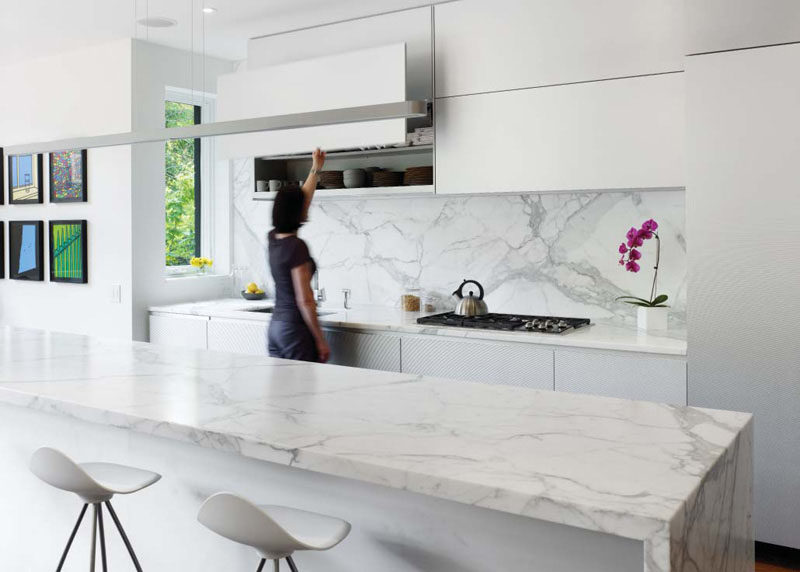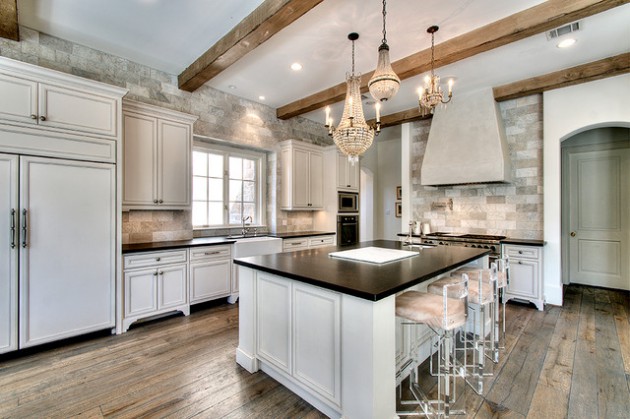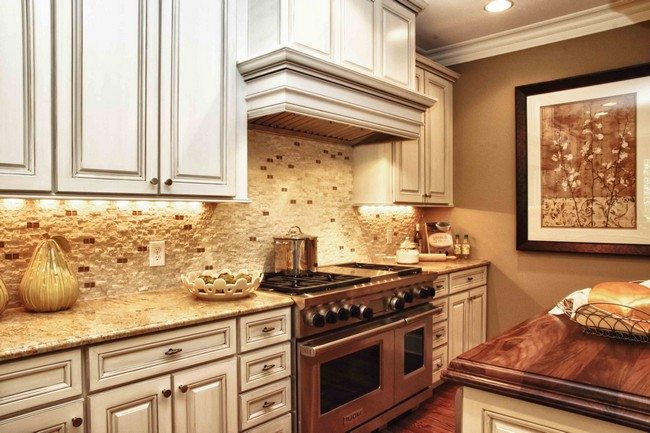Creating an Elegant Kitchen Backsplash
A kitchen backsplash serves as both a functional and aesthetic element in kitchen design. It protects walls from splashes and stains while enhancing the overall look of the kitchen. An elegant kitchen backsplash can transform a mundane kitchen into a sophisticated space. Let’s talk about creating an elegant kitchen backsplash, from selecting materials to design tips and common mistakes to avoid.

Choosing the Right Materials
Ceramic and Porcelain Tiles
Ceramic and porcelain tiles are popular choices for backsplashes due to their durability and wide range of styles. Ceramic tiles are available in numerous colors, patterns, and textures, allowing for endless design possibilities. Porcelain tiles, being denser and less porous, offer superior water resistance, making them ideal for kitchen environments.
When selecting ceramic or porcelain tiles, consider the overall theme of your kitchen. For a modern look, opt for sleek, glossy tiles in neutral tones. If you prefer a more traditional aesthetic, hand-painted ceramic tiles or those with intricate patterns can add a charming touch. Additionally, consider the tile size – larger tiles can create a seamless, expansive look, while smaller tiles or mosaics add texture and visual interest.
Installation of ceramic and porcelain tiles requires careful planning and precision. Ensuring that the tiles are evenly spaced and properly grouted is crucial for a polished finish. Professional installation is often recommended to achieve the best results, but experienced DIYers can also tackle this project with the right tools and patience.
Natural Stone
Natural stone, such as marble, granite, and travertine, brings an element of luxury to any kitchen. Each stone slab is unique, offering a one-of-a-kind aesthetic with its natural veining and color variations. Marble, in particular, is known for its timeless elegance, while granite is celebrated for its durability and resistance to heat and stains.
When choosing natural stone for your backsplash, it’s important to consider maintenance requirements. Some stones, like marble, are porous and can stain easily if not properly sealed. Regular sealing and prompt cleaning of spills are necessary to maintain the stone’s pristine appearance. Despite the maintenance, the unparalleled beauty of natural stone makes it a worthwhile investment for many homeowners.
The installation of natural stone backsplashes requires professional expertise. Stone slabs are heavy and require precise cutting and fitting. Proper installation ensures that the stone adheres well to the wall and that the seams between slabs are minimal, contributing to a seamless and elegant look.

Glass Tiles
Glass tiles offer a sleek and modern option for kitchen backsplashes. Their reflective surface can make a kitchen appear larger and brighter, adding a touch of sophistication. Glass tiles come in various colors, shapes, and finishes, including clear, frosted, and textured, allowing for creative design possibilities.
One of the advantages of glass tiles is their resistance to stains and ease of cleaning. However, they can be more expensive than other materials and may require special adhesives and grout to ensure proper installation. The reflective nature of glass tiles also means that fingerprints and smudges can be more noticeable, so regular cleaning is essential to maintain their appearance.
Installation of glass tiles can be challenging due to their transparency and fragility. Any imperfections in the wall behind the tiles can show through, so surface preparation is key. Additionally, cutting glass tiles requires specialized tools to avoid chipping. Hiring a professional installer can help achieve a flawless finish and ensure the longevity of the backsplash.
Metal Tiles
Metal tiles, including stainless steel, copper, and tin, provide a contemporary and industrial look to kitchen backsplashes. Stainless steel is particularly popular for its sleek, modern appearance and durability. Copper tiles add warmth and a rustic charm, while tin tiles can be embossed with intricate designs, offering a vintage aesthetic.
Metal tiles are easy to clean and resistant to heat and moisture, making them ideal for kitchen use. However, they can be prone to scratching and may develop a patina over time, particularly copper. This patina can be seen as a desirable characteristic, adding character to the backsplash, or it can be polished to maintain a shiny appearance.
Installation of metal tiles varies depending on the type. Stainless steel sheets can be adhered directly to the wall, while individual metal tiles may require spacers and grout. Proper adhesive is crucial to prevent tiles from shifting or falling. As with other materials, professional installation can ensure a high-quality finish.

Designing with Color and Pattern
Monochromatic Schemes
A monochromatic color scheme involves using different shades of a single color throughout the kitchen. This approach can create a cohesive and sophisticated look, especially when executed with varying textures and finishes. For instance, a white kitchen with a white marble backsplash can exude elegance and simplicity.
When designing a monochromatic backsplash, consider the overall mood you want to create. Cool colors like blues and grays can create a calming effect, while warmer tones like beige and taupe add warmth and coziness. The key is to incorporate different textures and finishes to add depth and interest to the design. Glossy tiles mixed with matte finishes or textured patterns can break up the monotony and create visual appeal.
A monochromatic backsplash can also highlight other elements in the kitchen, such as cabinetry and countertops. For example, a light gray backsplash can complement dark cabinets and a white countertop, creating a balanced and harmonious look. Lighting plays a crucial role in enhancing the monochromatic scheme, with under-cabinet lighting accentuating the backsplash’s texture and sheen.
Contrasting Colors
Using contrasting colors in the kitchen backsplash can make a bold statement and add vibrancy to the space. A black and white scheme is a classic choice, offering a timeless and sophisticated look. Alternatively, pairing a neutral kitchen with a colorful backsplash can create a striking focal point.
When incorporating contrasting colors, consider the overall balance of the kitchen. Bold colors should be used strategically to avoid overwhelming the space. For example, a brightly colored backsplash can be paired with neutral countertops and cabinetry to create a balanced and visually appealing design. Patterns and motifs can also play a significant role in contrasting designs, adding an extra layer of interest and complexity.
Contrast can also be achieved through the use of different materials and finishes. A matte black tile paired with glossy white tiles can create a dynamic and eye-catching backsplash. The key is to ensure that the contrasting elements complement each other and contribute to a cohesive overall design.

Geometric Patterns
Geometric patterns are a popular choice for backsplashes, adding a contemporary and stylish touch to the kitchen. Hexagons, chevrons, and herringbone patterns are among the favorites, offering a range of visual effects from subtle to bold. These patterns can be created using tiles of different colors or materials, enhancing the design’s complexity.
When designing a geometric backsplash, consider the scale of the pattern in relation to the size of the kitchen. Large patterns can make a small kitchen feel even smaller, while smaller patterns can create a sense of space and openness. Color choice is also crucial – monochromatic geometric patterns offer a sleek and modern look, while contrasting colors can make the pattern stand out.
Installation of geometric patterns requires precision to ensure that the tiles align correctly and the pattern is consistent. This can be a challenging task, particularly for intricate designs, so professional installation is often recommended. The result is a unique and elegant backsplash that serves as a focal point in the kitchen.
Mosaic Designs
Mosaic backsplashes offer a versatile and artistic option for kitchen design. They can be created using a variety of materials, including glass, ceramic, and stone, and come in a range of colors and patterns. Mosaics can depict intricate designs, from abstract patterns to detailed images, making them a unique and personal addition to the kitchen.
When choosing a mosaic design, consider the overall theme and style of your kitchen. Bright, colorful mosaics can add a playful touch, while more subdued tones can create an elegant and understated look. The key is to choose a design that complements the rest of the kitchen and reflects your taste.
Mosaic installation can be time-consuming and requires careful planning and attention to detail. Each piece must be placed accurately to create the desired pattern. While this can be a rewarding DIY project for those with patience and a steady hand, hiring a professional can ensure a flawless finish and save time and effort.
Subway Tiles
Subway tiles are a classic choice for kitchen backsplashes, offering a clean and timeless look. Originally used in New York City subway stations, these rectangular tiles have become a staple in kitchen design. They can be arranged in various patterns, including the traditional brick pattern, herringbone, and vertical stack, allowing for flexibility in design.
When using subway tiles, consider the color and finish. White subway tiles are the most common and offer a bright, clean appearance. However, colored subway tiles can add a unique twist, and different finishes, such as glossy or matte, can further customize the look. Grout color also plays a significant role – contrasting grout can highlight the tile pattern while matching grout creates a more seamless look.
Subway tiles are relatively easy to install, making them a popular choice for DIY projects. The key to a professional-looking installation is ensuring that the tiles are evenly spaced and level. Using tile spacers and a level can help achieve a precise and polished finish.

Practical Considerations
Budgeting and Planning
Creating an elegant kitchen backsplash involves careful budgeting and planning. The cost of materials, labor, and additional expenses, such as adhesives and grout, should be considered when setting a budget. High-end materials like natural stone and custom mosaics can be expensive, while more affordable options like ceramic tiles and standard subway tiles offer a stylish look without breaking the bank.
Planning involves measuring the area to be tiled and calculating the amount of material needed. It’s important to purchase extra tiles to account for breakage and future repairs. Additionally, consider the time and effort required for installation. While DIY projects can save money, professional installation ensures a high-quality finish and can be more cost-effective in the long run if mistakes are avoided.
Maintenance and Care
The longevity and appearance of a kitchen backsplash depend on proper maintenance and care. Different materials have different maintenance requirements. For example, natural stone needs regular sealing to prevent stains and damage, while ceramic and glass tiles are relatively low maintenance. Regular cleaning with appropriate products is essential to keep the backsplash looking its best.
Preventative measures can also help maintain the backsplash. Using cutting boards, trivets, and splash guards can protect the tiles from damage. Promptly cleaning up spills and splatters prevents stains and makes cleaning easier. Understanding the specific care requirements for your chosen material ensures that your backsplash remains elegant and functional for years to come.
Lighting and Accents
Lighting plays a crucial role in highlighting the beauty of a kitchen backsplash. Under-cabinet lighting can illuminate the backsplash, enhancing its colors and textures. LED strips, puck lights, or fluorescent fixtures are popular options. The choice of lighting can also influence the mood of the kitchen, with warm lights creating a cozy atmosphere and cool lights providing a modern, crisp look.
Accents, such as decorative tiles or borders, can add a personal touch to the backsplash. These can be used to create focal points or to break up larger areas of plain tiles. Choosing accents that complement the overall design and color scheme ensures a cohesive and elegant appearance.
Sustainability
For environmentally conscious homeowners, sustainable materials for kitchen backsplashes are an important consideration. Recycled glass tiles, reclaimed wood, and sustainably sourced natural stone are eco-friendly options. These materials reduce the environmental impact and often come with unique aesthetics that add character to the kitchen.
Additionally, sustainable installation practices, such as using low-VOC adhesives and grouts, contribute to a healthier indoor environment. Researching and choosing materials and practices that align with sustainability goals ensures that your elegant kitchen backsplash is also kind to the planet.
Customization and Personalization
Customizing and personalizing your kitchen backsplash allows you to create a space that truly reflects your style and personality. Custom mosaics, hand-painted tiles, and bespoke designs can make your backsplash one-of-a-kind. These unique elements add a personal touch and elevate the overall design.
When customizing your backsplash, consider your kitchen’s existing elements, such as cabinetry, countertops, and appliances. Ensuring that the custom elements complement these features creates a harmonious and cohesive look. Consulting with a designer can provide valuable insights and help bring your vision to life.
:max_bytes(150000):strip_icc()/DSC05210-4631884983364247967686a594c6b1e4.jpg)
Common Mistakes to Avoid
Choosing the Wrong Material
One of the most common mistakes is choosing a material that doesn’t suit your lifestyle or kitchen environment. For example, while marble is beautiful, it may not be practical for a busy kitchen prone to spills and stains. Consider the durability, maintenance requirements, and suitability of the material for your kitchen before making a decision.
Ignoring Grout
Grout is often overlooked but plays a crucial role in the overall appearance and durability of the backsplash. Choosing the wrong grout color or neglecting to properly seal grout can lead to discoloration and staining. Make sure to select a grout that complements your tiles and apply a sealant to protect it from moisture and stains.
Skipping Surface Preparation
Proper surface preparation is essential for a smooth and long-lasting installation. Skipping this step can result in uneven tiles and poor adhesion. Ensure that the wall surface is clean, dry, and free of any old adhesives or residues before starting the installation process.
Incorrect Tile Placement
Incorrect tile placement, such as uneven spacing or misaligned tiles, can ruin the look of the backsplash. Using tile spacers and a level during installation helps achieve precise and even placement. Taking the time to plan the layout and double-checking measurements ensures a professional-looking finish.
Overlooking Lighting
Lighting can dramatically affect the appearance of your backsplash. Neglecting to consider how lighting will interact with the tiles can lead to a lackluster look. Plan for adequate lighting to highlight the colors, textures, and patterns of your backsplash, enhancing its elegance and visual appeal.

What are the best materials for an elegant kitchen backsplash?
The best materials for an elegant kitchen backsplash include ceramic and porcelain tiles, natural stone, glass tiles, and metal tiles. Each material offers unique benefits, such as durability, ease of maintenance, and aesthetic appeal. The choice depends on your personal style, budget, and kitchen environment.
How do I choose the right color and pattern for my backsplash?
Choosing the right color and pattern involves considering the overall theme and style of your kitchen. Monochromatic schemes create a cohesive look, while contrasting colors add vibrancy. Geometric patterns and mosaics offer artistic options, and classic subway tiles provide a timeless appeal. Balance is key – ensure that the backsplash complements other elements in the kitchen.
Can I install a backsplash myself, or should I hire a professional?
While DIY installation is possible, hiring a professional is often recommended for the best results. Professional installers have the experience and tools to ensure precise and high-quality work. However, if you have the necessary skills and patience, DIY installation can be a rewarding project and save on labor costs.
How do I maintain and clean my kitchen backsplash?
Maintenance and cleaning depend on the material of the backsplash. Regular cleaning with appropriate products is essential. For natural stone, sealing is necessary to prevent stains. Ceramic and glass tiles are easier to clean and require less maintenance. Preventative measures, such as using splash guards and cleaning up spills promptly, help maintain the backsplash’s appearance.
What is the average cost of installing an elegant kitchen backsplash?
The cost varies widely depending on the materials and size of the area. High-end materials like natural stone and custom mosaics can be more expensive, while ceramic and standard subway tiles are more affordable. Labor costs also vary – professional installation adds to the expense but ensures a high-quality finish. Budgeting for both materials and labor is important to avoid unexpected costs.
Creating an elegant kitchen backsplash involves a careful selection of materials, thoughtful design, and attention to detail in installation and maintenance. By considering these factors, you can transform your kitchen into a sophisticated and stylish space that reflects your personal taste and enhances the overall functionality and beauty of your home.

Brilliant and Beautiful Kitchen Backsplash Ideas

Kitchen Design Ideas – Backsplash Ideas For A White Kitchen

Gorgeous Kitchens With Natural Stone Backsplash

Backsplash ideas to inspire you South East Tennessee & N. GA Real Estate :: The Edrington Team

Unique Kitchen Backsplash Ideas You Need to Know About – Decor Around The World

Related Posts:
- Cheap DIY Kitchen Backsplash
- Vinyl Kitchen Tiles Backsplash
- Small Kitchen Backsplash Ideas
- Modern Farmhouse Kitchen Backsplash
- Green Kitchen Backsplash Ideas
- Mexican Tile Backsplash Kitchen Ideas
- Rustic Stone Kitchen Backsplash
- Kitchen Backsplash Tile Ideas
- Decorative Kitchen Backsplash Ideas
- Kitchen Backsplash Tile Designs